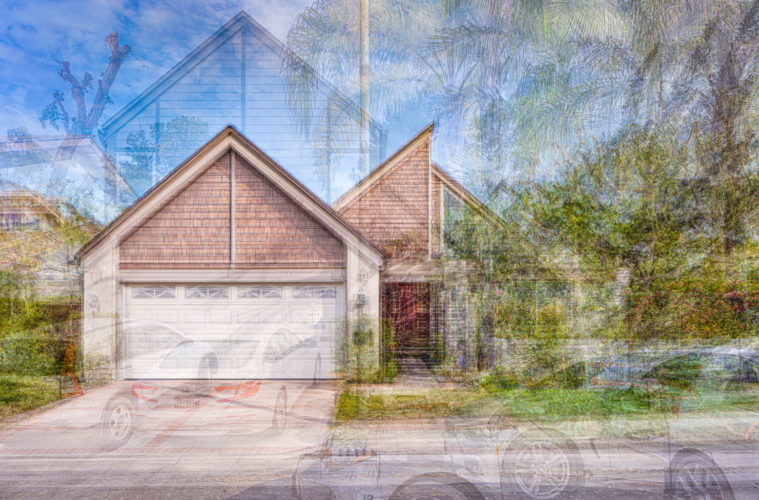As a recent Irvine resident (who moved here from Laguna Beach), I often feel as though I am driving through an imaginary village. I marvel at the flawlessness of the city with the trees and bushes trimmed to near perfection, and the cohesiveness of the housing.
This suburban environment is also recognized by Jesse Colin Jackson, an artist, designer and UC Irvine art professor, who photographed many of the modern and contemporary homes here for his innovative series, “The Villages of Irvine.”
(This series, part of Jackson’s exhibition, “Suburban Ecologies,” recently installed at Irvine’s Great Park Gallery, was curated by Adam Sabolick, Community Services Specialist for the city. As the lockdown prevented visitors from viewing the show and it is now closed, personal tours are available. See information below.)
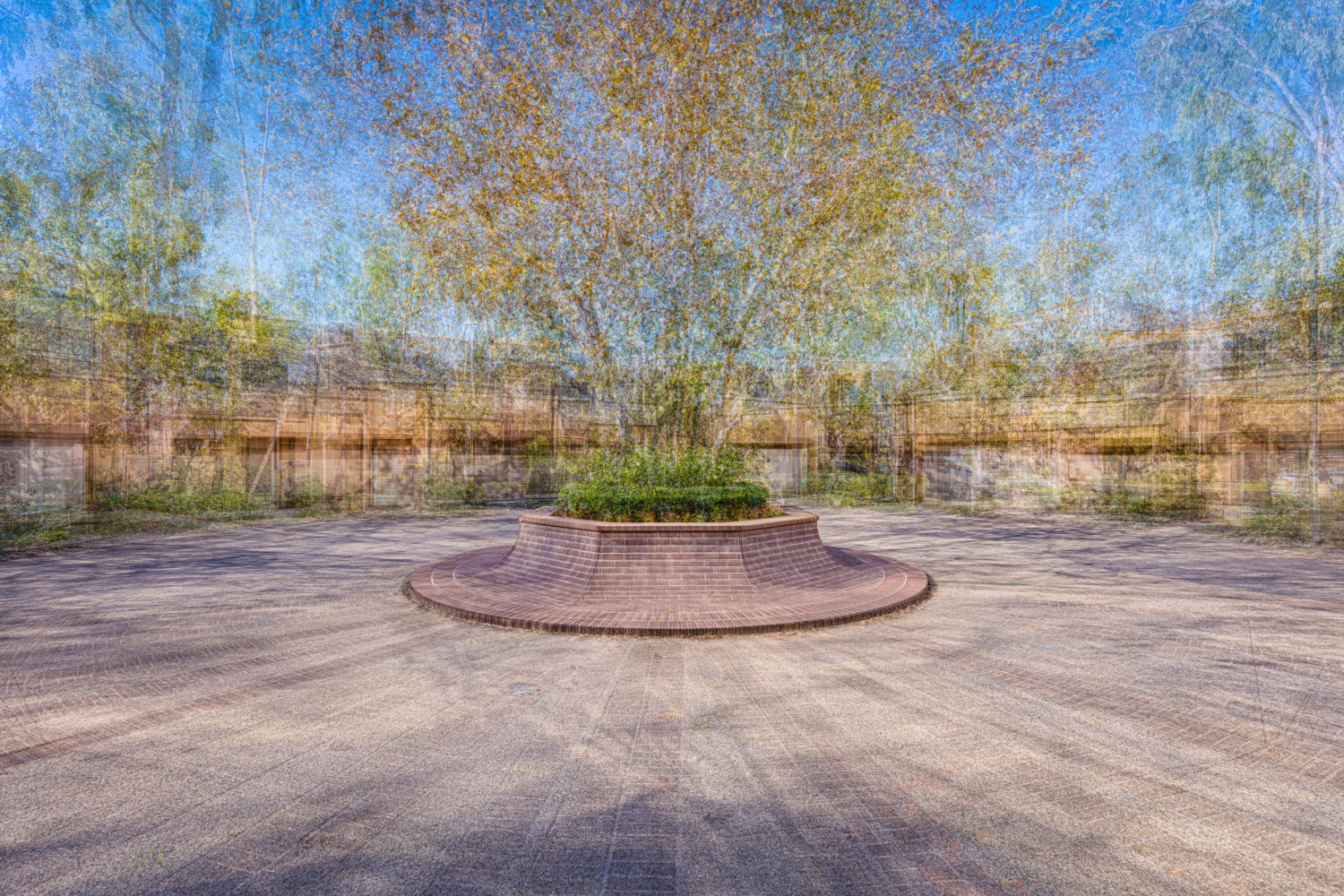
The Villages of Irvine: Turtle Rock #7
The “Villages” series was inspired by five Irvine villages – Northwood, Stonegate, Turtle Rock, University Park and Woodbridge – which Jackson visited many times over several months. His goal was to locate structures in each area that have similar design features, but are slightly different from each other. Or as he explains, “Less distinct are the individual buildings, which are subtly mirrored, shifted and finished in ways that maintain predictability while making it difficult to pinpoint exact copies.”
He ultimately created seven composite photos – six of homes and one of large planters in Turtle Rock – with each photo comprised of eight digitally overlayed images. Each resulting 36” high by 54” wide inkjet print brings to light the similarities of the structures; while their slight variations, enhanced by the digital manipulation, result in glistening artworks evoking the work of the French Impressionists, particularly their brushstrokes and depiction of light. They also suggest the paintings of Claude Monet, whose landscapes often illuminate the early morning mist.
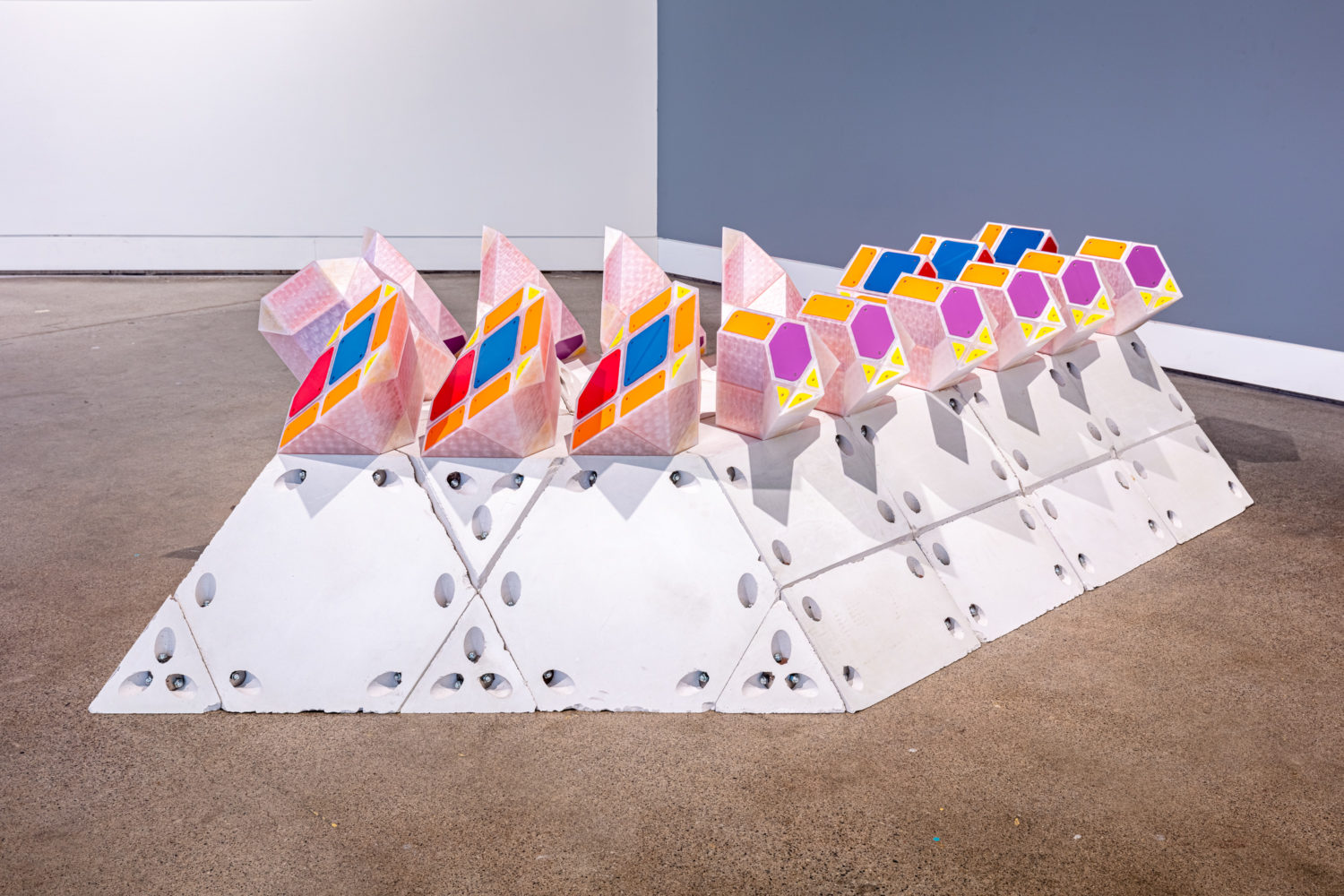
A Village of Irvine, as installed in Suburban Ecologies
As “Villages” further demonstrates, Jackson employs his skills in photoshop, photography and film. “I am part of the late Generation X, born in 1978. We were the first group who learned how to use computers as an integral part of everyday life, but we still had to build them from scratch and fix them from basic principles.” He adds, “I learned photography the old way, in the darkroom, but came of age artistically using digital technology.”
By merging his lifelong technical skills with artistry, Jackson transforms Irvine’s classic architecture into images of astonishing artistic splendor.
Jackson’s “The Orange Coast,” an organically inspired series in this exhibition, is composed of digitally overlayed panoramic shots of the shorelines and nearby environs in San Clemente, Dana Point, Laguna Beach, Newport Beach, Huntington Beach and Seal Beach. The resulting six 30” high by 90” wide inkjet prints, centered on the water’s horizon, illuminate the ocean, sand, surfers and birdwatchers, along with regional sights including the Huntington Beach and Seal Beach piers.

The Orange Coast #4 (Newport Beach)
The ocean – when viewed through the lens of multiple layers – appears to be churning as it would during a fierce storm, while the series portrays a mystical sweep of the ocean meeting sky and sand, evoking the romance and passion of our shorelines.
Jackson expresses his architectural training and skill in the creation of “Marching Cubes Watershed #2: Santa Ana” (58” high by 242” wide by 160” long), composed of 5,000 3D-printed PLA plastic components, with magnets affixed to them. The installation depicts the topography of Orange County and regions beyond as it progresses inland from the Santa Ana Watershed.
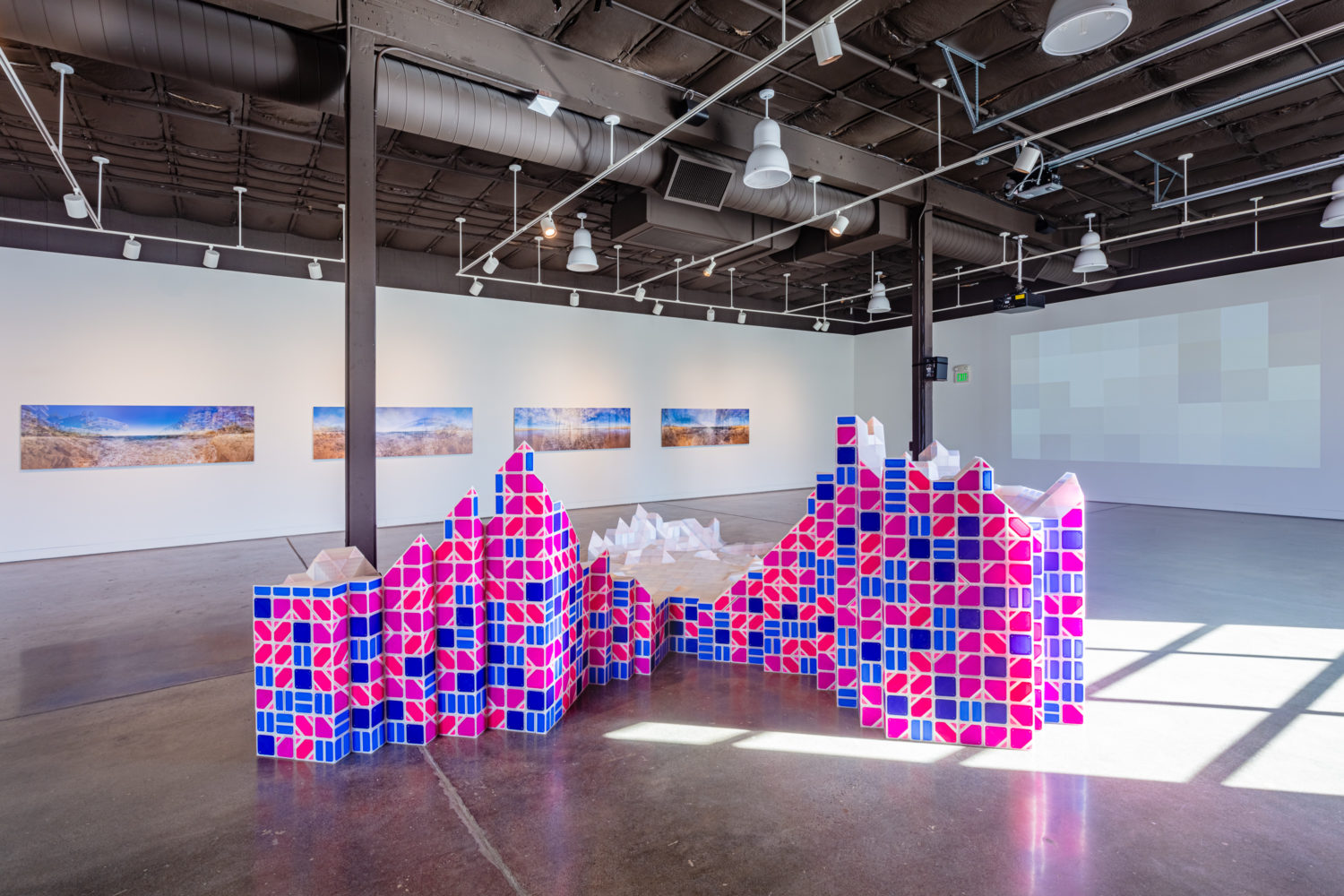
SANTA ANA WATERSHED
He explains, “Orange County’s historic orange groves, such as those found at the Irvine Ranch, were irrigated by the Santa Ana River, which brings water from Southern California’s highest points to its current artificial outlet at the border of Huntington Beach and Newport Beach.” The art piece also includes Saddleback Mountain, Big Bear Lake, Mount Baldy, and the San Jacinto and San Gorgonio Mountains.
As a low-slung sculpture with light filtering through it, “Marching Cubes” evokes the Southern California Light and Space movement of the 1960s and ‘70s: an immersive style in which various materials were used to create sculptures and installations reflecting the magnificent southland light.
Another series in this show, “Santa Ana Fall Line,” consists of two pixelated films on opposing walls in the gallery’s main room. Available for online viewing, these videos record a hiking/biking journey that Jackson and a friend pursued from the mouth of the Santa Ana River to the top of San Gorgonio Mountain, a trip of about 100 miles each way.
To create the films, Jackson and his friend, Nicholas Bradley, first shot 20,000 still images each of the terrain, foliage and people during the journey – one photo each minute – wearing body-mounted cameras. Jackson culled these to 10,433 frames per channel by deleting breaks and most of the night shots.
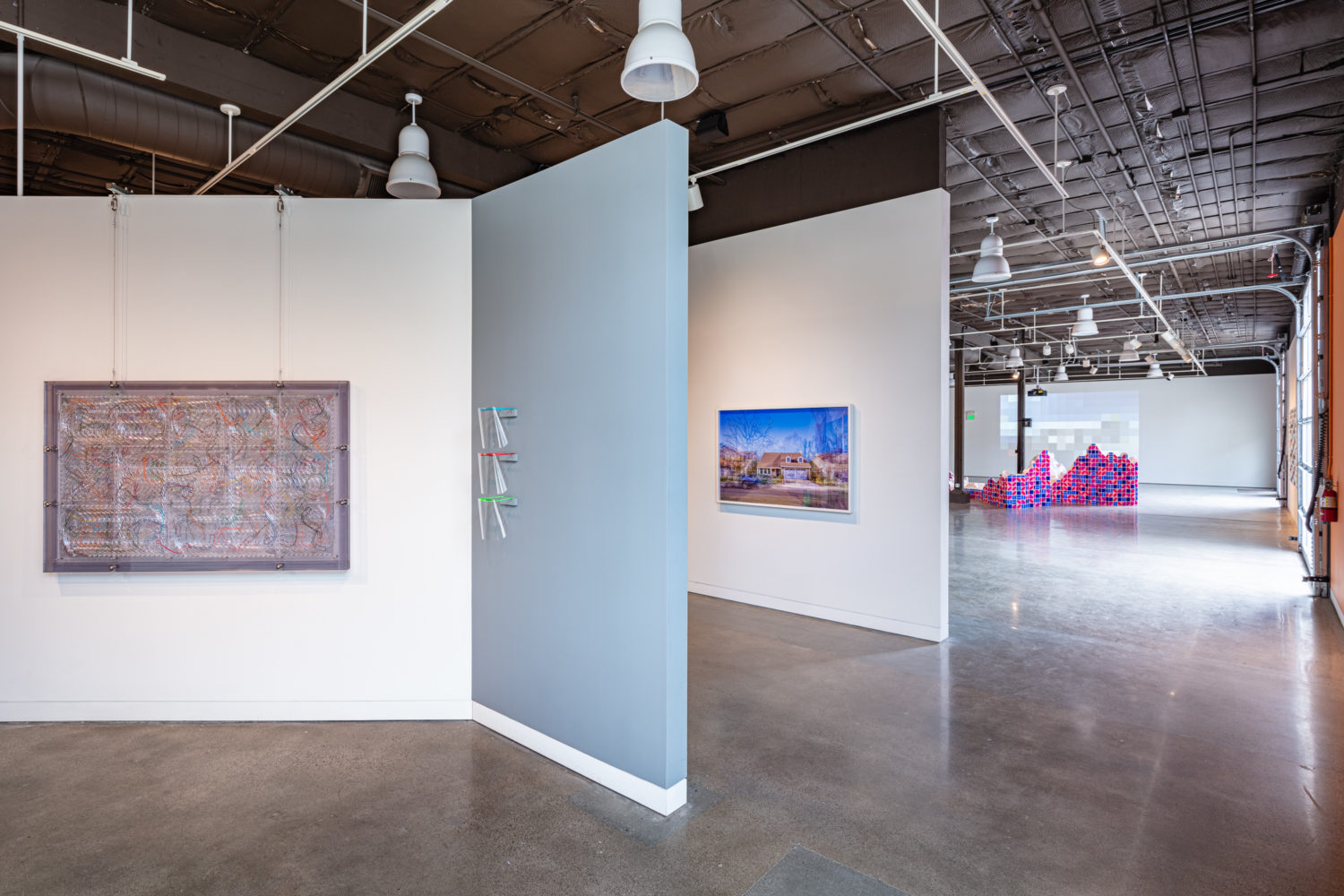
SUBURBAN ECOLOGIES
The first resulting film, with dissolving figuration, is redolent of the play of sunlight on flowing water, or of the appearance of movement in impressionist paintings, while echoing “The Orange Coast” series installed on the room’s side wall. The second more abstract film, comprised of large moving multi-colored squares, complements the “Marching Cubes” sculpture on the floor nearby.
“Suburban Ecologies” exhibits aspects of postmodernism as it contains borrowed elements, repeated design motifs and complex juxtapositions, while combining high art with images from daily life. It is a transcendent installation, created by an artist who intuitively uses the latest digital tools and methods in his work.
Jesse Colin Jackson creates artwork in his “Speculative Prototyping Lab” on campus at UC Irvine’s Claire Trevor School of the Arts. As visiting his lab is currently inaccessible, he has relocated his art-making to his home studio. He is pleased to receive visitors there to show his work from “Suburban Ecologies” and other projects. Art lovers can email him at [email protected] or call/text him at (949) 546-6515.
Meanwhile, enjoy a video tour and virtual tour of Jackson’s Great Park Gallery exhibition.

SUBURBAN ECOLOGIES
Advertising disclosure: We may receive compensation for some of the links in our stories. Thank you for supporting Irvine Weekly and our advertisers.

